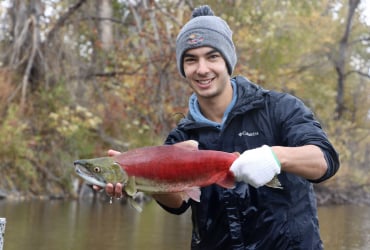The latest wave of COVID-19 is pushing healthcare resources in some remote Canadian communities to the limit as the number of cases increases.
Record cases have been documented across much of southern Canada in recent days, and while many hospitals report fewer critically ill patients than in previous waves, they are struggling with a higher rate of absenteeism because healthcare workers are they get sick in much more numbers.
Those tensions are exacerbated in remote communities where access to health care is already quite limited.
Bearskin Lake First Nation, a flying community in northern Ontario, declared a state of emergency on December 30 when 43 residents tested positive for the virus. By Sunday, 169 people had confirmed or suspected COVID-19 cases, more than 40 percent of the total population.
“That’s a crisis,” Nishnawbe Aski Nation’s Grand Chief Derek Fox said in an interview.
Bearskin Lake does not have a hospital and is generally staffed by a nursing station with two nurses. An emergency evacuation would take more than three hours for a plane to get in and out of Sioux Lookout or Thunder Bay, and that’s only if the weather allows it to land.
A federal rapid response team with three primary care nurses, a paramedic and two environmental health officers landed in Bearskin Lake on December 30, bringing with it more testing capacity. The Sioux Lookout First Nations Health Authority also dispatched two public health nurses.
What people are reading

Fox said it is not enough for a community that does not have a hospital or the capacity to determine how sick the infected residents are.
“The federal government and the provincial government must recognize that this is a crisis,” Fox said. “They are not treating this as a crisis. They are waiting to see what happens.”
He said that about a dozen of the 49 communities in the Nishnawbe Aski Nation have confirmed COVID-19 cases at this time, including 169 in Bearskin Lake, and about 80 more in 11 other First Nations.
Remote communities blocking, banning outsiders as COVID-19 spreads. # COVID-19
Indigenous Services Minister Patty Hajdu spoke to Fox by phone Sunday and said Ottawa is there to help.
“I reiterated that we will be there for them, to support them, and that they just need to keep telling us what they need and we will work very hard to make sure those resources are in place,” he said.
On Sunday, Hajdu said $ 483,000 had been approved to help Bearskin Lake with food safety, personal protective equipment, funding for local community COVID workers, and supplies like logging and harvesting.
She said that when so many people are sick and houses are only heated by wood stoves, even making sure there is wood to burn is a challenge.
Outbreaks in remote communities are also affecting Nunavut, northern Quebec and Labrador.
Nunavut confirmed another 22 COVID-19 cases on Sunday, bringing the total to 196 in just 10 days.
That’s more than a fifth of the confirmed COVID-19 cases in the territory since the pandemic began nearly two years ago, and the territory’s director of public health, Dr. Michael Patterson, says it’s putting enormous pressure on about health care.
“Please be patient and kind as there will be continued delays,” he said in a statement issued Sunday.
“Please stay home as much as possible and don’t take unnecessary chances.”
Nunavut is discouraging all non-essential travel within the territory and has banned non-essential travel to and from various communities, including Iqaluit, Rankin Inlet, Arviat, Igloolik, and Pangnirtung.
Travel bans are also in effect now in Nunavik, northern Quebec, until mid-January, and only critical or essential travel is allowed in or out of the 14 villages in the region.
The Nunavik Regional Board of Health and Human Services reported 33 new cases of COVID-19 in the week leading up to Christmas, and 131 between December 27 and December 31.
“The situation is serious,” the health board warned in a statement to the community on New Year’s Eve.
On the remote north coast of Labrador, where COVID-19 first appeared last week, leaders are pleading with residents to be cautious and impose strict travel restrictions on local communities.
Innu Nation Deputy Director Mary Ann Nui said in a Facebook post Sunday that the inability to get confirmed test results quickly adds to stress.
The Natuashish community shut down eight days ago after exposing potential cases on flights to the city and a bar at Trapper’s Cabin, just before Christmas. Nui said the alleged cases have yet to be confirmed.
“I suppose living in the north zone takes longer, but it shouldn’t be that way,” Nui wrote.
In Nain, the northernmost community of Labrador, there are 14 presumptive cases, detected by rapid tests, but confirming them with PCR tests is slow due to lack of supplies.
The Newfoundland and Labrador Health Minister said tests were being rolled out in the region, but said the increase in demand could not be predicted.
Nui said the local health region should have been more prepared.
Newfoundland and Labrador was one of several provinces that saw drastic spikes in COVID-19 case counts on Sunday, recording 466 new infections and beating a single-day record set just 24 hours earlier.
Nova Scotia also marked a new one-day peak on Sunday, recording 1,184 cases and eclipsing the 1,000 cases daily mark for the first time since the start of the pandemic. The province reported 1,893 new infections in the past two days.
A two-day count for Prince Edward Island was 137. Public health officials on the island say the total number of infections has nearly tripled in the past two weeks.
Ontario’s daily count fell short of Saturday’s record, but still amounted to 16,714, and the province now shows more than 100,000 active infections.
Quebec, meanwhile, recorded 15,845 new infections on Sunday.
This Canadian Press report was first published on January 2, 2022.
Reference-www.nationalobserver.com